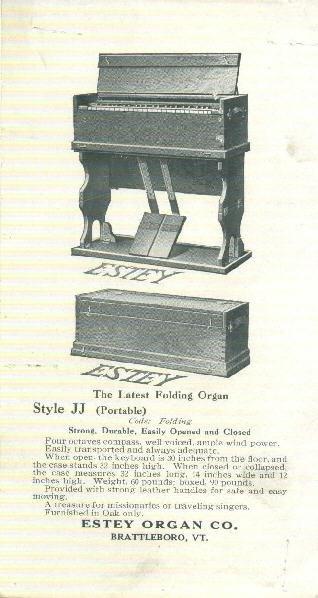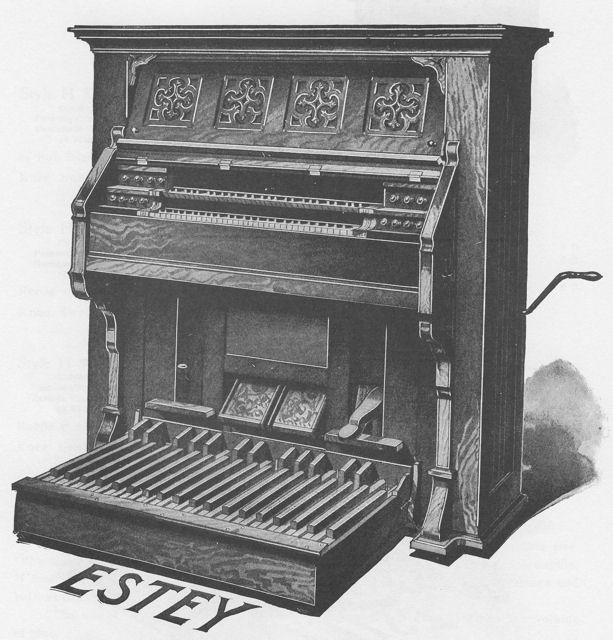

- Estey organ logo 1960 serial numbers#
- Estey organ logo 1960 serial number#
- Estey organ logo 1960 portable#
- Estey organ logo 1960 series#
- Estey organ logo 1960 download#
Estey organ logo 1960 serial numbers#
These serial numbers were generally stenciled on with paint, but some were stamped into the wood. The name then became property of Fletcher Music Centers, Clearwater, FL, who sold electronic organs with that brand name. The Estey name was later aquired by Miner Industries of New Kensington, PA, who made an electrically blown chord organ. By the time the company closed in the late 1950's they had built over 521,000 reed organs. Each Estey reed organ was numbered as it was shipped out. Serial numbers are generally found on a paper label on the back of the instrument. Determining the age of an Estey reed organ starts with identifying its serial number. The reeds were tuned in the organ 10-15-1901.
Estey organ logo 1960 serial number#
The label in Figure 2 traces the manufacturing of Estey Organ Serial Number 325469. Note that Estey serial numbers do not include a comma.
Estey organ logo 1960 download#
With the exponential possibilities of their combinations of pitch, timbre, and volume, “you have all these choices.”Īs in life: “You have to have some concept of the sound you want.=> Download Link serial number for estey organ

The Estey Organs, as Ned Phoenix has suggested, were the original synthesizers. (For years, the senior Estey’s vice president was his son-in-law, Levi Fuller, a polymath who would be elected Vermont’s governor in 1892.) Estey, who served in the Vermont state Senate, died in 1890, leaving the company in the hands of his son, Julius. The company namesake was “a classic Yankee,” says Waring - a shrewd businessman who made the most of his ingenuity and instincts. At the height of production, Estey had roughly 700 workers on the payroll. Barbara George will occasionally lead tours of the complex, which currently houses a blacksmith, a sculptor, a luthier, and an environmental consulting business, among other tenants.Īlong the ridge above the factory buildings sits a neighborhood long ago dubbed Esteyville, where company employees once lived. With a staff of volunteers, the museum opens in mid-May for the season, which runs through Columbus Day. The company, says Waring as he shows a visitor around the grounds on a recent spring Saturday, “is a slice of pure Americana.”
Estey organ logo 1960 series#
In addition to the restored organs and various ephemera, the museum currently showcases a series of portraits of latter-day Estey workers taken by the renowned photojournalist Clemens Kalischer, who died last year in Western Massachusetts at age 97. (Ford had an Estey organ installed at his Michigan estate.) He says Henry Ford once came to Brattleboro to compare notes on production line innovation. Waring, an ethnomusicologist, is the author of “Manufacturing the Muse,” a detailed account of the Estey story that places the company history in the context of America’s musical life and industrial development. Historian Dennis Waring says he stumbled on that one at a yard sale, hauling it home on the handlebars of his bike. In a back room, there’s even a plastic electronic model, about the size of a carry-on roller-bag, which dates to the dying days of the business. Founded in 2002 by local restoration expert Ned Phoenix, the museum features a few dozen examples of Estey instruments, from the bellows-driven melodeon, or “lap organ,” that got Estey started in the business, to the pedal-powered reed (or pump) organs that made the company’s name, and the pipe organs that followed around the turn of the century.

Ranging in size from miniature organs for children to a couple of thunderous beauties that tower high above the average tourist, the collection of the Estey Organ Museum celebrates the legacy of one of Vermont’s most significant products. “We’re probably the only musical instrument museum in the world that wants you to play the instruments,” says Barbara George, who owns eight of the slate-sided buildings - all listed on the National Register of Historic Places - in the former manufacturing complex. The sound of Estey’s historic organs lives on in a humble museum in the company’s old engine house on the edge of the factory yard, a short drive from Brattleboro’s Main Street.

Jacob Estey was the biggest name in organ manufacturing in the United States, and one of the biggest in the world.īut by the 1960s, the factory complex he built was shuttered for good, driven out of business by changing tastes and electronics.
Estey organ logo 1960 portable#
The company also produced a portable “folding organ,” which took the music outdoors, to theaters of war or, in the hands of missionaries, to the most rural of outposts. At the height of their popularity, Estey’s elaborate organs filled churches, middle-class parlors, and silent-movie theaters with lush, complex, and sometimes overwhelming sound.


 0 kommentar(er)
0 kommentar(er)
